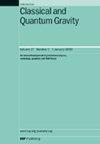Black Hole Waterfall: a unitary phenomenological model for black hole evaporation with Page curve
IF 3.6
3区 物理与天体物理
Q2 ASTRONOMY & ASTROPHYSICS
引用次数: 0
Abstract
We present a unitary phenomenological model for black hole (BH) evaporation based on the analogy of the laboratory process of spontaneous parametric down conversion (Alsing 2015 Class. Quantum Grav.32 075010; Alsing and Fanto 2016 Class. Quantum Grav.33 0150005) when the BH (pump) is allowed to deplete to zero mass. The model incorporates an additional new feature that allows for the interior Hawking partner-particles (idlers) behind the horizon to further generate new Hawking particle pairs of lower energy, one of which remains behind the horizon, and the other that adds to the externally emitted Hawking radiation (signals) outside the horizon. This model produces a Page curve for the evolution of the reduced density matrices for the evaporating BH internal degrees of freedom entangled with the generated Hawking radiation pairs entangled across the horizon. The Page curve yields an entropy that rises at early times during the evaporation process as Hawking pairs are generated, reaches a peak midway through the evolution, and then decays to zero upon complete evaporation of the BH. The entire system remains in a pure state at all times undergoing unitary (squeezed state) evolution, with the initial state of the BH modeled as a bosonic Fock state of large, but finite number of particles. For the final state of the system, the BH reaches the vacuum state of zero mass, while the external Hawking radiation carries away the total energy of the initial BH. Inside the horizon there remains Hawking partner-particles of vanishingly small total energy, reminiscent of the ‘soft-hair’ (zero energy) qubit model of Hotta et al (2018 Phys. Rev. Lett.120 181301), but now from a Hamiltonian for squeezed state generation perspective. The model presented here can be readily extended to encompass arbitrary initial pure states for the BH, and in falling matter.黑洞瀑布:具有Page曲线的黑洞蒸发的一元现象学模型
基于对实验室自发参数下转换过程的类比,我们提出了黑洞蒸发的统一现象学模型(Alsing 2015 Class)。Quantum gravity .32 075010;Alsing and Fanto 2016级。量子重力(Quantum gravity .33 0150005),当黑洞(泵)被允许耗尽到零质量时。该模型包含了一个额外的新特征,允许视界后的内部霍金伴侣粒子(闲散粒子)进一步产生能量较低的新霍金粒子对,其中一个留在视界后,另一个增加了视界外的外部发射的霍金辐射(信号)。该模型为蒸发黑洞内部自由度与产生的纠缠在视界上的霍金辐射对纠缠在一起的简化密度矩阵的演化产生了Page曲线。Page曲线产生的熵在蒸发过程的早期随着霍金对的产生而上升,在演化的中途达到峰值,然后在黑洞完全蒸发时衰减为零。整个系统在任何时候都保持在纯态,经历着酉态(压缩态)演化,黑洞的初始状态被建模为大但有限数量粒子的玻色子Fock状态。对于系统的最终状态,黑洞达到零质量的真空状态,而外部霍金辐射带走了初始黑洞的总能量。视界内仍然存在霍金伴侣——总能量极小的粒子,让人想起Hotta等人(2018年物理学)的“软毛”(零能量)量子比特模型。Rev. let .120 181301),但现在从压缩状态生成的角度来看哈密顿。这里提出的模型可以很容易地扩展到包括黑洞和下落物质的任意初始纯态。
本文章由计算机程序翻译,如有差异,请以英文原文为准。
求助全文
约1分钟内获得全文
求助全文
来源期刊

Classical and Quantum Gravity
物理-天文与天体物理
CiteScore
7.00
自引率
8.60%
发文量
301
审稿时长
2-4 weeks
期刊介绍:
Classical and Quantum Gravity is an established journal for physicists, mathematicians and cosmologists in the fields of gravitation and the theory of spacetime. The journal is now the acknowledged world leader in classical relativity and all areas of quantum gravity.
 求助内容:
求助内容: 应助结果提醒方式:
应助结果提醒方式:


